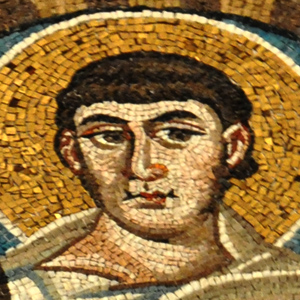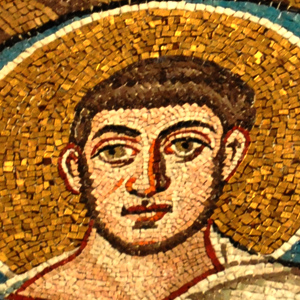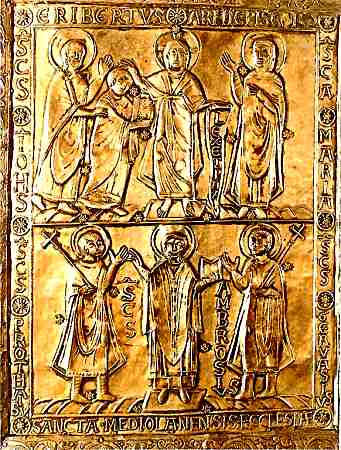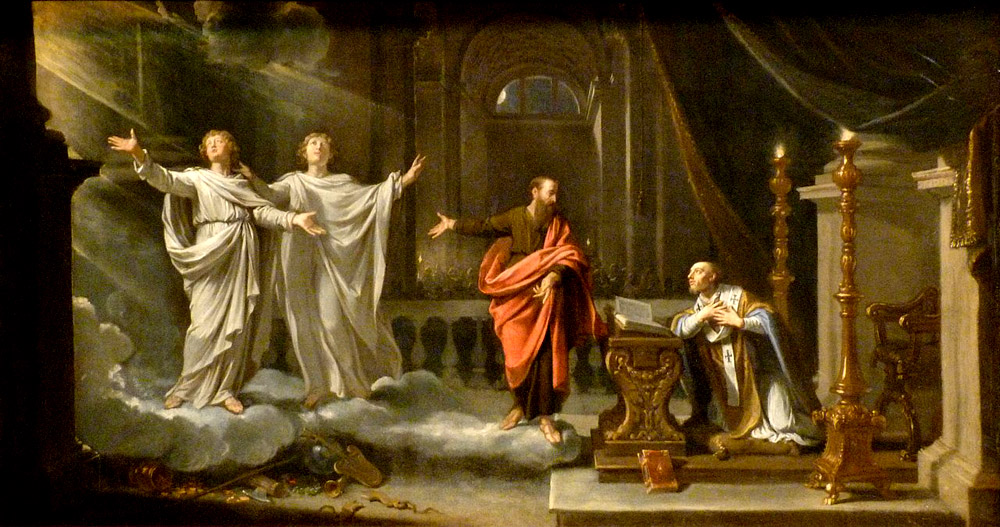Centuries afterward, a letter falsely attributed to Ambrose filled in the details we see in the image above. In it Ambrose has a vision one night of two youths wearing short boots and dressed in white pallia and colobia (mantles and sleeved garments). They appear again the second night, and on the third St. Paul appears and tells Ambrose where to dig for their relics. When they are found a note in the grave says they are Gervasius and Protasius, twin sons of the saints Valeria and Vitalis. The letter continues with an account of their martyrdom at the order of Count Astacius, who had been told he needed them to sacrifice to the gods if he wanted victory in battle. The youths refused, so one was beaten to death with cudgels and the other beheaded.2 This account is also in the Golden Legend, but it is not clear whether that work was based on the spurious letter or vice-versa.
PORTRAITS
The iconography of these saints is very unsettled, but a few features are relatively constant.Usually the twins are portrayed as handsome young men. In the letter attributed to Ambrose he calls them iuvenes ephebos – that is, youths of about 18-20 years old (ibid.). The Golden Legend (ibid.) calls them pulcherrimi iuvenes – "most beautiful" youths. In another instance of the art influencing the hagiography, the adjective may have been influenced by the way the two had already been pictured. In the 6th-century mosaics at right, for example, they are shown as handsome and beardless young men. They are also beardless, if perhaps less handsome, in the 11th-century book cover at right and in most later portraits.
A few images from later times do give them beards. In this one they also have swords and military garb. Neither the genuine letter of Ambrose's nor the spurious one says that they were soldiers, but their father Vitalis was an officer and a nobleman, so the assumption may have been that they had once followed in his footsteps, or simply that the profession of arms was appropriate for men of their age and status. The short boots, characteristic of soldiers, may also have supported such an assumption.
In portraits without the military garb, the saints' attributes are a scourge for Gervasius and a sword for Protasius (example). In one curious case Gervasius holds both a whip and a sword, as if he had been beheaded after the whipping. A statuary group in Milan also seems to assume that both were beheaded, as they have identical swords as their attributes.
Another attribute used occasionally is the hand cross, as in the book cover at right and in this mosaic in Sant'Ambrogio in Milan.
The white tunic and mantle specified in the Legend are perhaps the most common attributes both in portraits and in narrative images, as in the painting at the top of this page and this painting of their arrest.
In the Middle Ages the words colobium and pallium referred to liturgical vestments, which seems to be the reason that Gervasius and Protasius are sometimes dressed as deacons (example).
Prepared in 2013 by Richard Stracke, Emeritus Professor of English, Augusta University. Revised 2019-11-06.
HOME PAGE
Philippe de Champaigne, "Saints Gervase and Protase Appearing to St. Ambrose" (See the description page.)
OTHER IMAGES

Gervasius in the triumphal arch at San Vitale, Ravenna. (See the description page for a larger picture and commentary.)

Protasius in the same arch. (See the description page for a larger picture and commentary.)

With Ambrose, 11th century Gospel cover
ATTRIBUTES
- Swords
- A scourge
MORE IMAGES
- 19th-century painting of the martyrdom
- Gervase alone in a statuary group in Austria (problematic identification).
DATES
- Feast day: June 19
- 1st or 2nd century
NAMES
- Also known as Gervase and Protase
BIOGRAPHY
- Golden Legend #85: html or pdf.
- Acta Sanctorum, June vol. 3, 817-46.
- Roman Breviary: English translation, III, 638; Latin original, 892.
- Ambrose, The Finding of SS. Gervasius and Protasius.
NOTES
1 Acta Sanctorum, June vol. 3, 817, 819, 820. The contemporaries were St. Augustine and St. Paulinus of Nola.
2 Ibid., 821.
